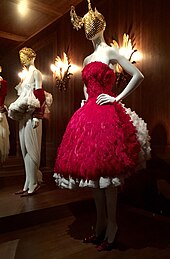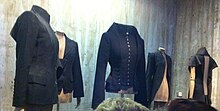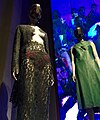
Lee Alexander McQueen was a British fashion designer and couturier. He founded his own Alexander McQueen label in 1992, and was chief designer at Givenchy from 1996 to 2001. His achievements in fashion earned him four British Designer of the Year awards, as well as the Council of Fashion Designers of America International Designer of the Year award in 2003. McQueen died by suicide in 2010 at the age of 40, at his home in Mayfair, London, shortly after the death of his mother.
Alexander McQueen is a British luxury fashion house founded by the designer Alexander McQueen in 1992. After his death, Sarah Burton was its creative director, from 2010 to 2023. Gianfilippo Testa has been CEO since March 2022 and Seán McGirr creative director since October 2023. The house specializes in haute couture, ready-to-wear, premium leather accessories, and footwear.
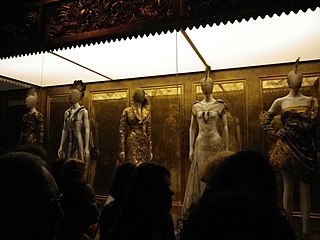
The Anna Wintour Costume Center is a wing of the Metropolitan Museum of Art main building in Manhattan that houses the collection of the Costume Institute, a curatorial department of the museum focused on fashion and costume design. The center is named after Anna Wintour, the longtime editor-in-chief of Vogue, Chief Content Officer of Condé Nast, and chair of the museum's annual Met Gala since 1995. It was endowed by Lizzie and Jonathan Tisch. As of August 2017, the chief curator is Andrew Bolton.
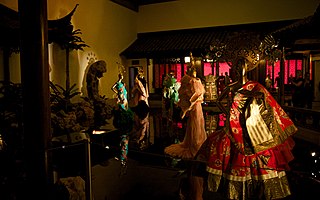
China: Through the Looking Glass was a fashion and art exhibition held from May 7 through August 16, 2015, at the Metropolitan Museum of Art focusing on the impact of Chinese design on Western fashion over the centuries. It was curated by Andrew Bolton with support from Harold Koda). Nathan Crowley was responsible for production design.
Andrew John Bolton is a British museum curator and current head curator of the Anna Wintour Costume Center at the Metropolitan Museum of Art in New York City, the host venue for the annual Met Gala.

Shaun Leane is a British jewellery designer best known for his sculptural pieces created for Alexander McQueen. His eponymous jewellery brand is a four-time winner of the UK Jewellery Designer of the Year award.
Susannah Frankel is a British fashion journalist and writer who, since the 1980s, has worked with a number of newspapers and publications. She was the leading journalist chosen by the Fashion Museum, Bath, to choose the defining Dress of the Year of 1999. Since 2001, she has also written and co-written a number of books on fashion designers.
Dante is the eighth collection launched by the British fashion designer Alexander McQueen. The concept for this collection was mainly inspired by the 14th century Florentine poet, writer and philosopher Dante Alighieri and his famous work Divine Comedy. The show was set in the Christ Church in Spitalfields on 1 March 1996. Some of the garments featured prints of Don McCullin’s photographs taken during the Vietnam War (1955-1975) and crucifix masks inspired in the photographer and a continuous referent in McQueen’s work, Joel-Peter Witkin’s self-portraits; the looks for this show also included Philip Treacy headpieces. The show was dedicated to McQueen’s long-time friend and muse, Isabella Blow; it constituted a commentary on religion and war.

It's a Jungle Out There is the tenth collection of the British fashion designer Alexander McQueen, and the first one released after his debut as the creative director of the French haute couture house Givenchy. The collection was presented at the Borough Market in February 1997 and it featured a total of 75 looks inspired by Thomson's gazelle. Fur, silk, leather and acid-washed denim were used for the confection of the garments; additionally, some of the pieces featured antlers and taxidermy crocodile heads, human hair and iron jewellery. Acclaimed by the press, this collection restated McQueen as one of the leading figures in fashion after his highly criticized debut with Givenchy. In 2011, several pieces were displayed in the exhibition dedicated to the designer's career, Alexander McQueen: Savage Beauty, at the Metropolitan Museum of Art in New York and, in 2015, at the Victoria and Albert Museum in London.

The armadillo shoe is a high fashion platform shoe created by British fashion designer Alexander McQueen for his final collection, Plato's Atlantis. Only 24 pairs exist: 21 were made during the initial production in 2009, and three were made in 2015 for a charity auction. The shoes are named for their unusual convex curved shape, said to resemble an armadillo. Each pair is approximately 12 inches (30 cm) from top to sole, with a 9-inch (23 cm) stiletto heel; this extreme height caused some models to refuse to walk in the Plato's Atlantis show. American singer Lady Gaga famously wore the shoes in several public appearances, including the music video for her 2009 single "Bad Romance".

The Widows of Culloden is the twenty-eighth collection by British fashion designer Alexander McQueen, made for the Autumn/Winter 2006 season of his eponymous fashion house. It was inspired by his Scottish ancestry and is regarded as one of his most autobiographical collections. It is named for the women widowed by the Battle of Culloden (1746), often seen as a major conflict between Scotland and England. Widows makes extensive use of the McQueen family tartan and traditional gamekeeper's tweeds, as well as other elements taken from Highland dress. Historical elements reflected the fashion of the late Victorian era and the 1950s.

The illusion of Kate Moss is an art piece first shown at the conclusion of the Alexander McQueen runway show The Widows of Culloden. It consists of a short film of English model Kate Moss dancing slowly while wearing a long, billowing gown of white chiffon, projected life-size within a glass pyramid in the centre of the show's catwalk. Although sometimes referred to as a hologram, the illusion was made using a 19th-century theatre technique called Pepper's ghost.
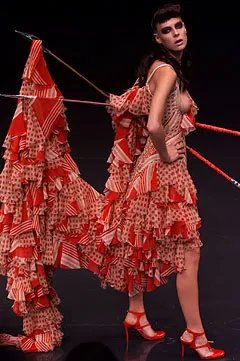
The Dance of the Twisted Bull is the nineteenth collection by British designer Alexander McQueen for his eponymous fashion house. Twisted Bull was inspired by Spanish culture and art, especially the traditional clothing worn for flamenco dancing and bullfighting. In McQueen's typical fashion, the collection included sharp tailoring and historicist elements and emphasised femininity and sexuality.

Neptune is the twenty-seventh collection by British designer Alexander McQueen for his eponymous fashion house. It took inspiration from classical Greek clothing, 1980s fashion, and the work of artists influential in that decade. The runway show was staged during Paris Fashion Week on 7 October 2005 at the industrial warehouse of the Imprimerie Nationale. Two main phases were presented, with 56 looks total: the first phase comprised monochrome black clothing, while the second featured a white, green, and gold palette. The collection's clothing and runway show both lacked McQueen's signature theatricality, and critical reception at launch and in retrospect was negative. Items from Neptune appeared in the 2022 exhibition Lee Alexander McQueen: Mind, Mythos, Muse.

Taxi Driver is the second collection by the British designer Alexander McQueen for his eponymous fashion house. It was named after the 1976 film Taxi Driver, and his father, a London taxicab driver. McQueen developed the collection following his 1992 graduation from Central Saint Martins art school. At the time he was unemployed and seeking a job in the fashion industry; although he was reluctant to launch his own company, he worked on designs to pass the time. The collection included experimental techniques and silhouettes, most notably the bumster trouser, whose extremely low waist exposed the top of the intergluteal cleft.

The oyster dress is a high fashion gown created by British fashion designer Alexander McQueen for his Spring/Summer 2003 collection Irere. McQueen's design is a one-shouldered dress in bias-cut beige silk chiffon with a boned upper body and a full-length skirt consisting of hundreds of individual circles of organza sewn in dense layers to the base fabric, resembling the outside of an oyster shell. According to McQueen, the gown took a month's work for three people, who cut and assembled all the pieces individually. In addition to the original beige dress, a version with a red bodice and the ruffled skirt in rainbow colours was also created. The beige and red versions appeared in the Irere runway show, and were photographed for magazines to promote the collection.
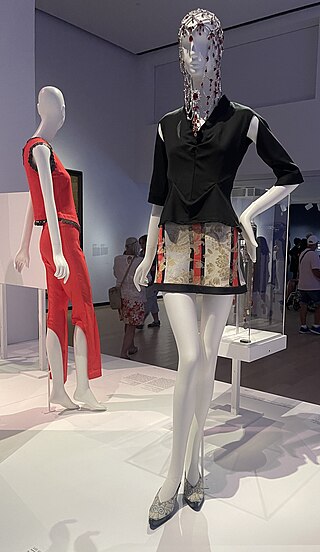
Eye was the fifteenth collection by British fashion designer Alexander McQueen for his eponymous fashion house. It was inspired by the culture of the Middle East, particularly Islamic clothing, as well as the oppression of women in Islamic culture and their resistance to it. The collection crossed traditional Middle Eastern garments with elements drawn from Western fashion such as sportswear and fetishwear. Jeweller and frequent McQueen collaborator Shaun Leane provided the collection's best-known design: a yashmak made from chainmail.

The Overlook was the fourteenth collection by British fashion designer Alexander McQueen for his eponymous fashion house. It was inspired by the Stanley Kubrick horror film The Shining (1980) and named for the fictional Overlook Hotel where much of the film takes place. The collection focused on winter clothing in light and neutral colours, including chunky knitwear, fur and shearling coats, and parkas inspired by Inuit clothing. Showpiece items included a bustier made from rock crystal and a corset made from coils of aluminium, the latter provided by jeweller and frequent McQueen collaborator Shaun Leane.

The Girl Who Lived in the Tree is the thirty-second collection by British fashion designer Alexander McQueen, made for the Autumn/Winter 2008 season of his eponymous fashion house. The primary inspirations were British culture and national symbols, particularly the British monarchy, as well as the clothing of India during the British Raj. The collection was presented through the narrative of a fairy tale about a feral girl who lived in a tree before falling in love with a prince and descending to become a princess.

